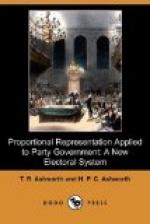It is very desirable that the first election be contested on definite policies advanced by the prospective party leaders; the suggestion that the first ministry should be merely a provisional ministry, to act till the first responsible ministry is formed after the election, is therefore open to serious objection. The leader of the Freetrade party or the leader of the Protectionist party should be chosen as first Federal Premier, and the first election should decide which policy is to be adopted.
Contrast this scheme with the proposals now under consideration. In Victoria, New South Wales, and Queensland bills have been introduced dividing the States into single-membered electorates, and some of the smaller States are inclined to use the Block Vote. In Victoria a bad precedent has been established by giving the party in power the duty of determining boundaries. From time to time it will be necessary to rearrange the boundaries, not only on account of movements of population within the State, but also because the number of representatives which the State is entitled to will vary. Look forward to the time when the State becomes entitled to one more representative; every one of the 23 electorates, in which vested interests will have been created, will have to be altered These are precisely the conditions which have led to the growth of the gerrymander in the United States.
Already the first scheme submitted to the Assembly has been defeated by a combination of country members, who held that Melbourne was allotted a larger share of representation than it now has in the local Parliament. Whatever may be the arguments by which the disparity between the size of town and country electorates be supported in local affairs, surely they cannot apply where national issues only are at stake. The principle of equal electorates is recognized in the Commonwealth Bill by the rules for allotting representation to the States. Why not, then, for the divisions of each State? It is said that a larger proportion of the electors vote in the town, but it is not those only who vote who are represented.




